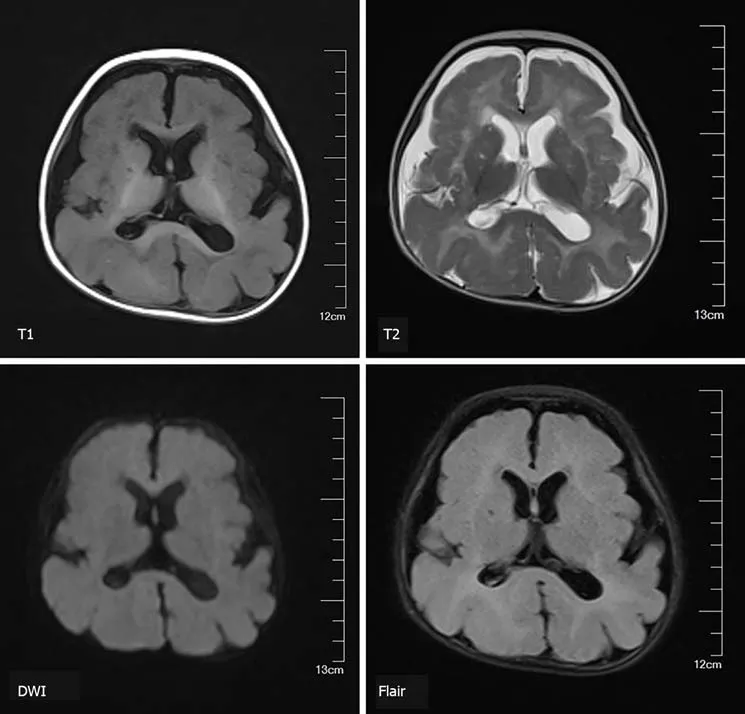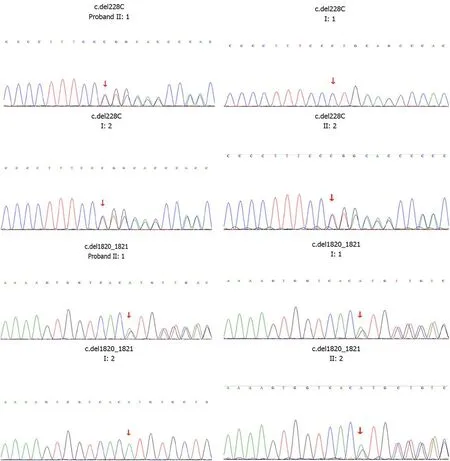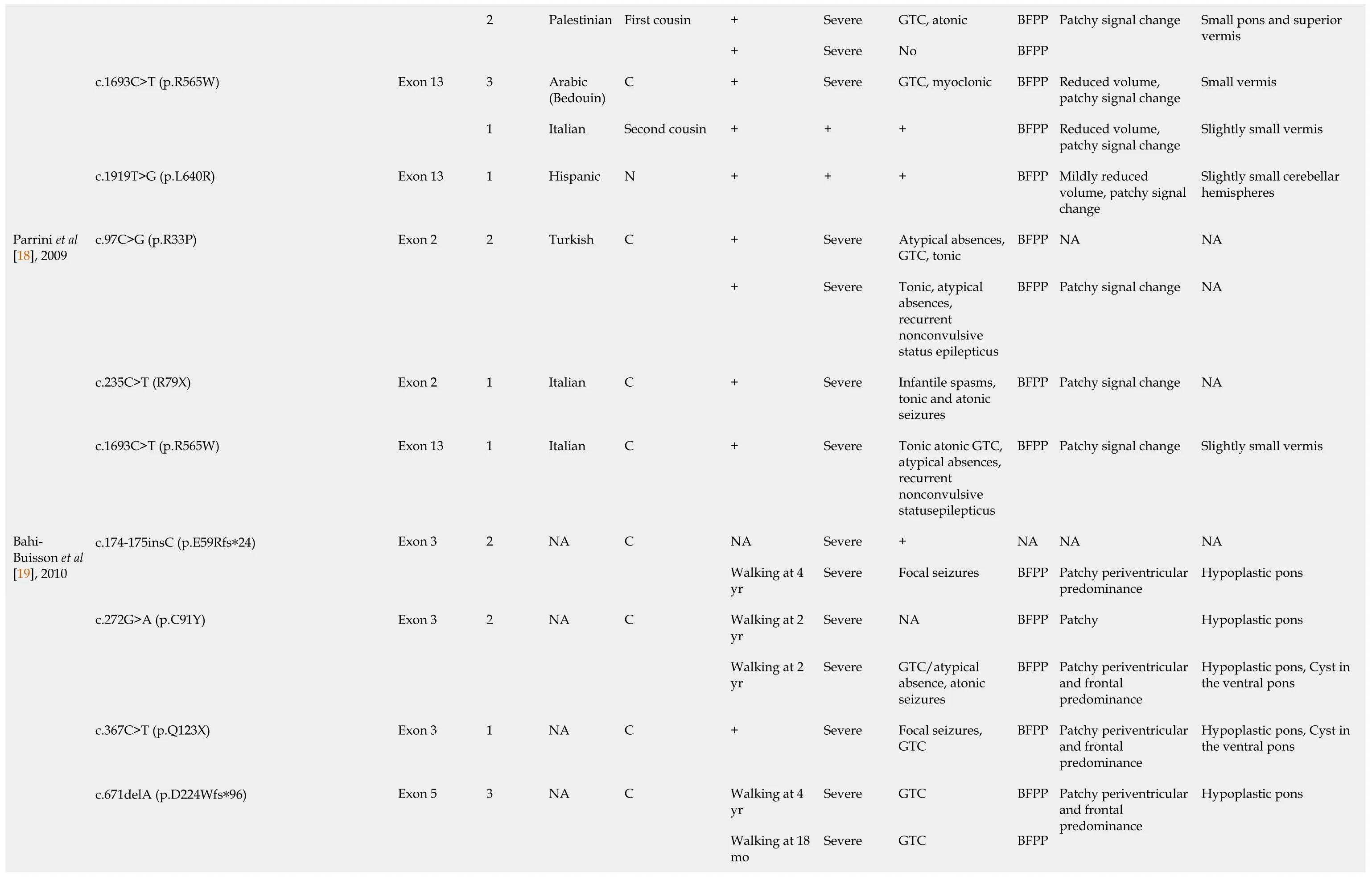Novel compound heterozygous GPR56 gene mutation in a twin with lissencephaly:A case report
INTRODUCTION
Lissencephaly (LIS) is a group of abnormal cerebral cortical dysplasias caused by the defective migration of neurons.It can be diagnosed clinically by neuroimaging.It is characterized by thickening of the cerebral cortex,widening of the gyri,and disappearance or shallowness of the sulci.The complete disappearance of the sulci and gyri showing smooth surface of the brain is called agyria and is seen in severe cases[1].According to the neuroimaging,LIS is divided into six grades,ranging from severe agyria (grade 1) to mild subcortical band heterotopias (grade 6).The severity of nerve damage is closely related to the grade of LIS and cortical thickening,and the mortality rate of severe LIS is high[2].In the early stages,patients often exhibit developmental delays and hypotonia,followed by seizures,and a severe intellectual disability eventually.Although a LIS patient may develop normally in the neonatal period,many neonates suffer from persistent feeding problems and different types of epilepsy,which are difficult to cure[3].An individual with mild LIS and normal intelligence has been reported[4].Currently,20 genes have been implicated in LIS.Many of these genes are microtubule genes[5,6].
(OMIM#606854,NM_0001145773) encodes an orphan G protein-coupled receptor (GPCR) that is extensively expressed in the nervous system and is essential for the normal development of the cerebral cortex and cerebellar morphology[7-9].The reported mutations of thegene have been confirmed to be related to bilateral frontoparietal polymicrogyria (BFPP)[10].
Then no time must be lost, said Hyacinthia, and she immediately turned herself into a river, Prince Milan into an iron bridge, and the charger into a blackbird
Herein,we report a twin infant with LIS who came from a nonconsanguineous family.The twins both carried a novel compound heterozygousmutation.To our knowledge,this is the first case of-related LIS.
CASE PRESENTATION
Chief complaints
A 5-mo-old female infant was hospitalized due to repeated convulsions for 1 d.
History of present illness
Thegene spans 45 kb and consists of 14 exons encoding an orphan GPCR of 693 amino acids[7,11].GPR56 is a member of the adhesion GPCR family,which has an N-and a C-terminal fragment and a GPCR proteolytic site[12].In the central nervous system,GPR56 plays an important role in the normal development of the cerebral cortex and cerebellar morphogenesis[8].In the peripheral nervous system,GPR56 can regulate the formation and maintenance of myelin sheaths[13].Therefore,the normal expression of GPR56 is essential for the function of the nervous system.
History of past illness
The patient had no history of past illness.
Personal and family history
The patient was the first child of nonconsanguineous Chinese parents.She was delivered by cesarean section due to twin pregnancy at 32 wk of gestation,with a birth weight of 2.6 kg.No intrauterine distress or postnatal asphyxia had occurred.She had a twin sister with LIS.
Physical examination
The patient showed a flat head deformity.The neurological examination was normal.There were no other abnormal signs.
Laboratory examinations
She told Gerda not to be sad, and that she should stay with her and take of the cherry trees and flowers, which were better than any picture-bok, as they could each tell a story
The electroencephalography and laboratory findings (full blood count,liver,kidney and thyroid function tests,creatine kinase,uric acid,metabolic study and chromosome karyotyping) were normal.
Imaging examinations
Brain magnetic resonance imaging (MRI) revealed a simple brain structure,with widened and thickened gyri and shallow sulci.The white matter of the brain was significantly reduced.The patchy long T1 and long T2 signals could be seen around the ventricles,which were expanded,and the extracerebral space was widened(Figure 1).
The patient experienced repeated convulsions after she was discharged from hospital.The convulsions occurred once a day to more than ten times a day without any causes,each episode lasting several minutes.She died 3 mo later.
FINAL DIAGNOSIS
Faith realises it, and the priests tell us so, replied herhusband; but amid all my happiness I feel that it is arrogant todemand a continuation of it- another life after this. Has not somuch been given us in this world that we ought to be, we must be,contented with it?
According to the clinical characteristics,imaging and genetic test findings (Figure 2),the infant was diagnosed with LIS.


TREATMENT
It is known that mutations of thegene are related to BFPP (Table 1).The clinical manifestations of BFPP are overall growth retardation and seizures.MRI shows symmetrical polygyria (the frontal parietal area is the most serious part),ventricular enlargement,and bilateral white matter changes.Twenty-eight pathogenicmutations related to the BFPP phenotype have been reported[11,14].The affected individuals inherit the mutants in an autosomal recessive mode.The majority of missense mutations resulted in similar clinical symptoms,indicating that the similar phenotype might be caused by the same mechanism.However,the mechanism remains unclear,although it may involve GPR56 trafficking and a decrease in receptor levels at the cell membrane[15-17].GPR56 knockdown did not affect the migration of neural progenitor cells,while GPR56 overexpression inhibited the migration of neural progenitor cells.This mechanism might occur through the reorganization of cerebral cortex actin to change the cell morphology and regulate neural progenitor cell behavior[8].LIS is caused by premature stop of neuronal migration,which might explain the mechanism of the GPR56 mutations causing LIS in the present case.
OUTCOME AND FOLLOW-UP
As the mailman5 takes my envelope from me forever, I wonder if I ve made the right decision. Do I have the right to force myself into Beth s life again? Am I simply part of the past? I have taken the first step. Beth has control of the situation now.
DISCUSSION
The patient was admitted to the Children’s Hospital of Nanjing Medical University due to repeated convulsions.The patient had a sudden onset of generalized tonicclonic seizures without any causes.In addition,she had a flat head deformity and developmental delays.
During the hospital stay,the patient had no epileptic seizures.She received rehabilitation,but anti-epileptic treatment was refused.




The development of the brain is a delicate and complex physiological process,and the proper migration of neurons is one of the most critical steps.LIS is brain dysplasia caused by the premature stop of neuronal migration.Type I LIS is characterized by a thickened cerebral cortex (10-20 mm,whereas normal is 4 mm),but no other brain development malformations,such as severe congenital microcephaly,corpus callosum hypoplasia,or cerebellar hypoplasia[2].Microscopically,the cerebral cortex in LIS is divided into four thick and dysplastic layers:The molecular layer,the superficial cellular layer,the cell spare layer,and the deeper cellular layer;the normal cerebral cortex has six layers[1].
She soon breathed again and came to herself; but the young King had watched the proceeding38, and not knowing why Trusty John had acted as he did, he flew into a passion, and cried: Throw him into prison
Currently,20 genes have been reported to be associated with LIS,and many of them are microtubule genes[5,6].In a cohort study of 811 patients with LIS,the overall mutation frequency of the entire cohort was 81%,of whichaccounted for 40%,followed by(23%),(5%),and(3%).Other genes accounted for 1% or less.Interestingly,the cause of LIS in 19% of the patients was unknown,which indicates that additional genes are involved and need to be discovered[6].There have been no other reports of LIS caused bygene mutations.Therefore,the relationship between LIS andstill needs further research.
There is no specific treatment method for LIS.Current treatments typically involve symptomatic relief,such as anti-epileptic treatment and rehabilitation training.Studies in animal models have shown that it might be possible to restart neuronal migration by re-expressing the missing/nonfunctional genes after birth[2].Even if the degree of cortical deformity is partially improved,it may significantly decrease seizure frequency and clinical severity[2].Therefore,with the advances in genetic testing and medical technology,the diagnosis and treatment of LIS will continue to be improved and optimized.
“What strange conduct,” said the emperor, when her flight had been discovered; and all the courtiers blamed her, and said she was a very ungrateful creature.
CONCLUSION
The compound mutations in thegene identified in the twin sisters with LIS were novel and unreported mutations.This finding has broadened our knowledge of the clinical manifestations of LIS and increased our understanding of.Genetic testing is necessary when patients suffer from LIS symptoms.
We sincerely appreciate the patients and their parents for their help and willingness in this study.
 World Journal of Clinical Cases2022年2期
World Journal of Clinical Cases2022年2期
- World Journal of Clinical Cases的其它文章
- New trends in treatment of muscle fatigue throughout rehabilitation of elderlies with motor neuron diseases
- What emotion dimensions can affect working memory performance in healthy adults? A review
- Quadrilateral plate fractures of the acetabulum:Classification,approach,implant therapy and related research progress
- Methylprednisolone accelerate chest computed tomography absorption in COVID-19:A three-centered retrospective case control study from China
- Analysis of photostimulable phosphor image plate artifacts and their prevalence
- N6-methyladenine-modified DNA was decreased in Alzheimer’s disease patients
